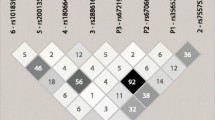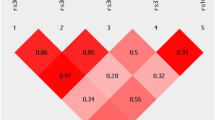Abstract
Nitric oxide synthase (NOS) genes (NOS1, NOS2A, and NOS3) may create excess nitric oxide that contributes to neurodegeneration in Parkinson’s disease (PD). NOS genes might also interact with one another or with environmental factors in PD. Coding and tagging single nucleotide polymorphisms (SNPs) (27 NOS1, 18 NOS2A, and five NOS3 SNPs) were genotyped in families with PD (1,065 cases and 1,180 relative and other controls) and were tested for allelic associations with PD using the association in the presence of linkage test and the pedigree disequilibrium test (PDT), allelic associations with age-at-onset (AAO) using the quantitative transmission disequilibrium test, and interactions using the multifactor dimensionality reduction—PDT. Gene–environment interactions involving cigarette smoking, caffeine, nonsteroidal anti-inflammatory drugs, and pesticides were examined using generalized estimating equations in participants with environmental data available. Significant associations with PD were detected for the NOS1 SNPs rs3782218, rs11068447, rs7295972, rs2293052, rs12829185, rs1047735, rs3741475, and rs2682826 (range of p = 0.00083–0.046) and the NOS2A SNPs rs2072324, rs944725, rs12944039, rs2248814, rs2297516, rs1060826, and rs2255929 (range of p = 0.0000040–0.047) in earlier-onset families with sporadic PD, and some SNPs were also associated with earlier AAO. There was no compelling statistical evidence for gene–gene interactions. However, of the significantly associated SNPs, interactions were found between pesticides and the NOS1 SNPs rs12829185, rs1047735, and rs2682826 (range of p = 0.012–0.034) and between smoking and the NOS2A SNPs rs2248814 (p = 0.021) and rs1060826 (p = 0.013). These data implicate NOS1 and NOS2A as genetic risk factors for PD and demonstrate that their interactions with established environmental factors may modulate the environmental effects.



Similar content being viewed by others
References
McDonald WM, Richard IH, DeLong MR (2003) Prevalence, etiology, and treatment of depression in Parkinson’s disease. Biol Psychiatry 54:363–375 doi:10.1016/S0006-3223(03)00530-4
Fearnley JM, Lees AJ (1991) Ageing and Parkinson’s disease: substantia nigra regional selectivity. Brain 114(Pt 5):2283–2301 doi:10.1093/brain/114.5.2283
Coppede F, Mancuso M, Siciliano G, Migliore L, Murri L (2006) Genes and the environment in neurodegeneration. Biosci Rep 26:341–367 doi:10.1007/s10540-006-9028-6
Wood-Kaczmar A, Gandhi S, Wood NW (2006) Understanding the molecular causes of Parkinson’s disease. Trends Mol Med 12:521–528 doi:10.1016/j.molmed.2006.09.007
Benmoyal-Segal L, Soreq H (2006) Gene-environment interactions in sporadic Parkinson’s disease. J Neurochem 97:1740–1755 doi:10.1111/j.1471-4159.2006.03937.x
Ebadi M, Sharma SK (2003) Peroxynitrite and mitochondrial dysfunction in the pathogenesis of Parkinson’s disease. Antioxid Redox Signal 5:319–335 doi:10.1089/152308603322110896
Colasanti M, Suzuki H (2000) The dual personality of NO. Trends Pharmacol Sci 21:249–252 doi:10.1016/S0165-6147(00)01499-1
Hancock DB, Martin ER, Fujiwara K, Stacy MA, Scott BL, Stajich JM et al (2006) NOS2A and the modulating effect of cigarette smoking in Parkinson’s disease. Ann Neurol 60:366–373 doi:10.1002/ana.20915
Hague S, Peuralinna T, Eerola J, Hellstrom O, Tienari PJ, Singleton AB (2004) Confirmation of the protective effect of iNOS in an independent cohort of Parkinson disease. Neurology 62:635–636
Levecque C, Elbaz A, Clavel J, Richard F, Vidal JS, Amouyel P et al (2003) Association between Parkinson’s disease and polymorphisms in the nNOS and iNOS genes in a community-based case-control study. Hum Mol Genet 12:79–86 doi:10.1093/hmg/ddg009
Huerta C, Sanchez-Ferrero E, Coto E, Blazquez M, Ribacoba R, Guisasola LM et al (2007) No association between Parkinson’s disease and three polymorphisms in the eNOS, nNOS, and iNOS genes. Neurosci Lett 413:202–205 doi:10.1016/j.neulet.2006.11.044
Schulte C, Sharma M, Mueller JC, Lichtner P, Prestel J, Berg D et al (2006) Comprehensive association analysis of the NOS2A gene with Parkinson disease. Neurology 67:2080–2082 doi:10.1212/01.wnl.0000247672.41736.bd
Persichini T, Cantoni O, Suzuki H, Colasanti M (2006) Cross-talk between constitutive and inducible NO synthase: an update. Antioxid Redox Signal 8:949–954 doi:10.1089/ars.2006.8.949
Hernan MA, Takkouche B, Caamano-Isorna F, Gestal-Otero JJ (2002) A meta-analysis of coffee drinking, cigarette smoking, and the risk of Parkinson’s disease. Ann Neurol 52:276–284 doi:10.1002/ana.10277
Hancock DB, Martin ER, Stajich JM, Jewett R, Stacy MA, Scott BL et al (2007) Smoking, caffeine, and nonsteroidal anti-inflammatory drugs in families with Parkinson disease. Arch Neurol 64:576–580 doi:10.1001/archneur.64.4.576
Chen H, Jacobs E, Schwarzschild MA, McCullough ML, Calle EE, Thun MJ et al (2005) Nonsteroidal antiinflammatory drug use and the risk for Parkinson’s disease. Ann Neurol 58:963–967 doi:10.1002/ana.20682
Chen H, Zhang SM, Hernan MA, Schwarzschild MA, Willett WC, Colditz GA et al (2003) Nonsteroidal anti-inflammatory drugs and the risk of Parkinson disease. Arch Neurol 60:1059–1064 doi:10.1001/archneur.60.8.1059
Priyadarshi A, Khuder SA, Schaub EA, Priyadarshi SS (2001) Environmental risk factors and Parkinson’s disease: a metaanalysis. Environ Res 86:122–127 doi:10.1006/enrs.2001.4264
Hancock DB, Martin ER, Mayhew GM, Stajich JM, Jewett R, Stacy MA et al (2008) Pesticide exposure and risk of Parkinson’s disease: a family-based case-control study. BMC Neurol 8:6 doi:10.1186/1471-2377-8-6
Reider CR, Halter CA, Castelluccio PF, Oakes D, Nichols WC, Foroud T (2003) Reliability of reported age at onset for Parkinson’s disease. Mov Disord 18:275–279 doi:10.1002/mds.10391
The International HapMap Consortium (2003) The International HapMap Project. Nature 426:789–796 doi:10.1038/nature02168
de Bakker PI, Yelensky R, Pe’er I, Gabriel SB, Daly MJ, Altshuler D (2005) Efficiency and power in genetic association studies. Nat Genet 37:1217–1223 doi:10.1038/ng1669
Barrett JC, Fry B, Maller J, Daly MJ (2005) Haploview: analysis and visualization of LD and haplotype maps. Bioinformatics 21:263–265 doi:10.1093/bioinformatics/bth457
Lewis PO, Zaykin D (2000) Genetic data analysis: Computer program for analysis of allelic data, version 1.0 (d15)
Martin ER, Bass MP, Hauser ER, Kaplan NL (2003) Accounting for linkage in family-based tests of association with missing parental genotypes. Am J Hum Genet 73:1016–1026 doi:10.1086/378779
Martin ER, Bass MP, Kaplan NL (2001) Correcting for a potential bias in the pedigree disequilibrium test. Am J Hum Genet 68:1065–1067 doi:10.1086/319525
Martin ER, Monks SA, Warren LL, Kaplan NL (2000) A test for linkage and association in general pedigrees: the pedigree disequilibrium test. Am J Hum Genet 67:146–154 doi:10.1086/302957
Nicodemus KK, Luna A, Shugart YY (2007) An evaluation of power and type I error of single-nucleotide polymorphism transmission/disequilibrium-based statistical methods under different family structures, missing parental data, and population stratification. Am J Hum Genet 80:178–185 doi:10.1086/510498
Martin ER, Bass MP, Gilbert JR, Pericak-Vance MA, Hauser ER (2003) Genotype-based association test for general pedigrees: the genotype-PDT. Genet Epidemiol 25:203–213 doi:10.1002/gepi.10258
Sellbach AN, Boyle RS, Silburn PA, Mellick GD (2006) Parkinson’s disease and family history. Parkinsonism Relat Disord 12:399–409 doi:10.1016/j.parkreldis.2006.03.002
Monks SA, Kaplan NL, Weir BS (1998) A comparative study of sibship tests of linkage and/or association. Am J Hum Genet 63:1507–1516 doi:10.1086/302104
Ritchie MD, Hahn LW, Roodi N, Bailey LR, Dupont WD, Parl FF et al (2001) Multifactor-dimensionality reduction reveals high-order interactions among estrogen-metabolism genes in sporadic breast cancer. Am J Hum Genet 69:138–147 doi:10.1086/321276
Martin ER, Ritchie MD, Hahn L, Kang S, Moore JH (2006) A novel method to identify gene–gene effects in nuclear families: the MDR-PDT. Genet Epidemiol 30:111–123 doi:10.1002/gepi.20128
Coffey CS, Hebert PR, Ritchie MD, Krumholz HM, Gaziano JM, Ridker PM et al (2004) An application of conditional logistic regression and multifactor dimensionality reduction for detecting gene–gene interactions on risk of myocardial infarction: the importance of model validation. BMC Bioinformatics 5:49 doi:10.1186/1471-2105-5-49
Ma DQ, Whitehead PL, Menold MM, Martin ER, Ashley-Koch AE, Mei H et al (2005) Identification of significant association and gene–gene interaction of GABA receptor subunit genes in autism. Am J Hum Genet 77:377–388 doi:10.1086/433195
Hancock DB, Martin ER, Li YJ, Scott WK (2007) Methods for interaction analyses using family-based case-control data: conditional logistic regression versus generalized estimating equations. Genet Epidemiol 31:883–893 doi:10.1002/gepi.20249
Przedborski S, Jackson-Lewis V, Yokoyama R, Shibata T, Dawson VL, Dawson TM (1996) Role of neuronal nitric oxide in 1-methyl-4-phenyl-1,2,3,6-tetrahydropyridine (MPTP)-induced dopaminergic neurotoxicity. Proc Natl Acad Sci U S A 93:4565–4571 doi:10.1073/pnas.93.10.4565
Dehmer T, Lindenau J, Haid S, Dichgans J, Schulz JB (2000) Deficiency of inducible nitric oxide synthase protects against MPTP toxicity in vivo. J Neurochem 74:2213–2216 doi:10.1046/j.1471-4159.2000.0742213.x
Liberatore GT, Jackson-Lewis V, Vukosavic S, Mandir AS, Vila M, McAuliffe WG et al (1999) Inducible nitric oxide synthase stimulates dopaminergic neurodegeneration in the MPTP model of Parkinson disease. Nat Med 5:1403–1409 doi:10.1038/70978
Arimoto T, Bing G (2003) Up-regulation of inducible nitric oxide synthase in the substantia nigra by lipopolysaccharide causes microglial activation and neurodegeneration. Neurobiol Dis 12:35–45 doi:10.1016/S0969-9961(02)00017-7
Hunot S, Boissiere F, Faucheux B, Brugg B, Mouatt-Prigent A, Agid Y et al (1996) Nitric oxide synthase and neuronal vulnerability in Parkinson’s disease. Neuroscience 72:355–363 doi:10.1016/0306-4522(95)00578-1
Lin PI, Vance JM, Pericak-Vance MA, Martin ER (2007) No gene is an island: the flip-flop phenomenon. Am J Hum Genet 80:531–538 doi:10.1086/512133
Witte JS, Gauderman WJ, Thomas DC (1999) Asymptotic bias and efficiency in case-control studies of candidate genes and gene–environment interactions: basic family designs. Am J Epidemiol 149:693–705
Bashkatova V, Alam M, Vanin A, Schmidt WJ (2004) Chronic administration of rotenone increases levels of nitric oxide and lipid peroxidation products in rat brain. Exp Neurol 186:235–241 doi:10.1016/j.expneurol.2003.12.005
Day BJ, Patel M, Calavetta L, Chang LY, Stamler JS (1999) A mechanism of paraquat toxicity involving nitric oxide synthase. Proc Natl Acad Sci U S A 96:12760–12765 doi:10.1073/pnas.96.22.12760
Mazzio EA, Kolta MG, Reams RR, Soliman KF (2005) Inhibitory effects of cigarette smoke on glial inducible nitric oxide synthase and lack of protective properties against oxidative neurotoxins in vitro. Neurotoxicology 26:49–62 doi:10.1016/j.neuro.2004.07.005
Acknowledgments
We are grateful to the individuals with PD and their families for their participation in our study. This work was supported by National Institutes of Health/National Institute of Neurological Disorders and Stroke grants NS39764 (to J.M.V.) and NS056632 (to D.B.H.).
Author information
Authors and Affiliations
Corresponding author
Rights and permissions
About this article
Cite this article
Hancock, D.B., Martin, E.R., Vance, J.M. et al. Nitric oxide synthase genes and their interactions with environmental factors in Parkinson’s disease. Neurogenetics 9, 249–262 (2008). https://doi.org/10.1007/s10048-008-0137-1
Received:
Accepted:
Published:
Issue Date:
DOI: https://doi.org/10.1007/s10048-008-0137-1




